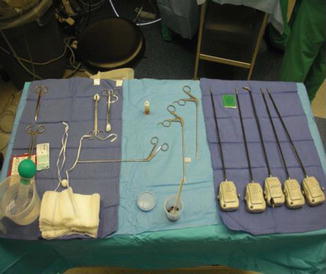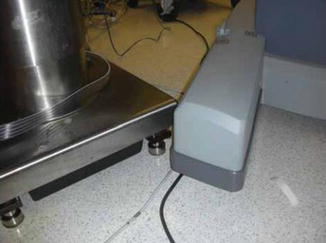Fig. 1
Diagram showing typical OR setup for TORS case. Da Vinci® Transoral surgery procedure guide. PN 871671 Rev. D 3/11 [2]
The room setup should provide adequate space for surgical personnel to move around the room. Extraneous equipment should be removed from the room to maximize available space. The procedural case cart, surgeon consoles, and ancillary equipment should be positioned at the periphery of the room. The rest of the needed equipment should also be placed and set up at the periphery of the room and positioned so that there is a clear pathway to the patient surgical bed once the patient is in the room. The patient surgical bed should be set up for efficient patient transfer from the stretcher and assembled appropriately for a TORS procedure. The head attachment of the patient surgical bed should be placed at the foot of the bed, and the base of the bed should be turned 180° so that the patient’s head will rest on the repositioned head attachment. This bed arrangement allows space for the base of the patient-side cart to fit under the bed. The sterile surgical tables should be set up at the periphery of the room at the foot of the patient’s surgical bed, with a clear pathway to move at the beginning of the procedure. The patient-side cart is then draped and the camera-endoscope units are calibrated. Before the patient is brought into the room it should be confirmed that all appropriate equipment is present, turned on, and functioning properly including all three components of the da Vinci® Robotic System.
Patient Positioning
Once the patient enters the room the entire surgical team should be focused on the patient’s comfort and safety. When the patient is safely transferred and secured on the surgical bed, a universal protocol is performed and general endotracheal anesthesia is induced.
The bed is turned 180° with the patient’s feet towards anesthesia. An extended breathing circuit is used to reach the endotracheal tube. All intravenous lines and monitoring lines are positioned for easy access by the anesthesiologist and cushioned with gauze to prevent undue pressure on the patient. Both of the patient’s arms are wrapped in gel arm wraps. Arms are then tucked at the patient’s side. The patient’s head is placed on a low profile “gel donut.” The vertex of the patient’s head should be at the very edge of the OR table. Other equipment needed for TORS procedures may include a foam or gel mattress and warming blanket. Once the head of the patient surgical bed is turned 180° from the anesthesia machine, the suction machine, electro-cautery machine, sequential compression device, blanket warmer, and other equipment should be placed near the patient’s feet, beside or behind the anesthesia machine to avoid interference with the robotic equipment.
Surgical Assistant Positioning
The assistant to the surgeon positioned at the patient’s head attends to the surgical site with handheld instruments. The assistant observes the surgical site directly and well on one of the video monitors and performs tasks such as suctioning, cautery, applying vascular clips, and ensuring that robotic arms do not cause injury to patient.
Equipment Tables
Tables that hold the endoscopes, robotic instruments, various mouth gags, and other instruments used are placed behind the surgical assistant and scrub nurse for easy access and interchange during the procedure (Figs. 1, 2, and 3).



Fig. 2
Setup of the camera cart. Da Vinci® Transoral surgery procedure guide. PN 871671 Rev. D 3/11 [2]

Fig. 3
Positioning of the OR table and patient-side cart. Da Vinci® transoral surgery procedure guide. PN 871671 Rev. D 3/11 [2]
Anesthesia Considerations
The patient should be intubated with a single lumen reinforced tube for oropharynx cases. If the laser is used or the hypopharynx or larynx will be instrumented close to the endotracheal tube, then a laser safe tube should be employed to minimize airway fire risk. The route of intubation (nasal or oral) and the position of the endotracheal tube depend on the specific type of TORS procedure being performed and on surgeon preference.
Da Vinci® Robot Patient-Side Cart Setup
(a)




Docking
The patient-side cart is moved to the edge of the patient bed and aligned at a 30° angle from the long axis of the patient surgical bed. It is important to note that some surgical beds have a wider base that limits proximity of patient-side cart base to the patient. In those instances an alternative position may be needed or the surgical bed may need to be changed. The relationship of the surgical bed base and the base of the patient-side cart is the same for every case; therefore, it may facilitate faster room setup if permanent marks are placed on the OR floor to allow staff to position the equipment appropriately each time (Fig. 3).
< div class='tao-gold-member'>
Only gold members can continue reading. Log In or Register to continue
Stay updated, free articles. Join our Telegram channel

Full access? Get Clinical Tree


